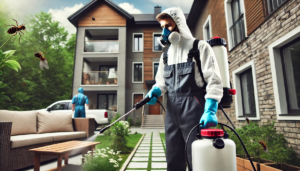Pest Control Simi Valley CA, is the management of pests in human environments. It focuses on preventative strategies such as exclusion, sanitation, and eradication. It also involves suppression and biological control.
Look for a company specializing in the type of pest you’re dealing with. Ask about licenses, copies of pesticide labels, and application rates.

Pest control involves keeping a pest population below the level that would cause damage. This is usually achieved through prevention and suppression. Prevention is the preferred method, as it causes less harm to people, animals, and plants than other forms of pest control. However, if prevention is not possible or ineffective, the next best options are to use suppression and then eradication methods.
Often, the presence of pests can be prevented by maintaining good hygiene. This may include storing food in sealed containers and making sure that rubbish is regularly collected. It can also involve installing pest proofing into buildings, especially in food or retail environments. This includes putting up barriers or ‘pest screens’ that prevent rodents, birds and insects from entering buildings in the first place.
Some species of pests are not always considered to be pests, but they can become a problem if their numbers get out of hand. This is the case with some birds, such as pigeons or seagulls, and some wild creatures, such as squirrels or foxes. These pests can still be a nuisance, particularly in areas where they are gathering for food.
Many types of pests have natural enemies that keep their numbers in check. These may be parasites, predators, or pathogens. Humans can supplement these natural controls by introducing additional enemies, such as sterile males or the use of pheromones. This form of pest control is called biological control and can be very effective.
Weather conditions can have a direct effect on the size of a pest population, as they can affect growth and development or kill off host plants. Climate can also indirectly influence the population of pests, such as affecting the availability of water and shelter.
Chemical pesticides are substances that kill or inhibit the growth of pests, but they are generally only used if other controls fail. They are usually very toxic and should only be used by fully qualified pest control technicians. They must wear appropriate protective clothing and follow other safety precautions.
Biological pest controls involve using the organisms that naturally regulate the populations of harmful organisms, such as bacteria, fungi and viruses. They can be added to other forms of pest control, such as physical traps or baits, or they can be used on their own. For example, nematodes are tiny worms that live in soil and water. They help break down organic matter, but they can also be detrimental to plants by causing them to develop diseases.
Suppression
Some pests have a “zero tolerance” threshold and cannot be allowed to exist in certain environments because of the severe human health, environmental or economic damage they cause. Eradication is the goal in these situations. In greenhouses and other confined environments, suppression often works in conjunction with prevention to keep pest populations below harmful levels.
Various physical, mechanical, and chemical control methods may be used to suppress pests. Many of these methods involve blocking access to the plant or structure by pests, creating barriers they can’t cross. Examples include the use of barriers made of metal strips, netting, screens, caulking and other materials. Biological controls can also be effective, especially in greenhouses. These are often based on the conservation or release of natural enemies of the pest. Examples of natural enemies are predators, parasitoids and pathogens, such as tachinid flies that prey on mite pests in orchards, nematodes that kill harmful soil grubs and ichneumonid wasps that parasitize greenhouse whitefly.
Other physical and chemical control measures are designed to prevent the growth of the plant or crop by depriving it of nutrients, moisture or light needed for normal development. This includes the use of barriers to prevent pests from entering or exiting a facility, securing and maintaining machinery and equipment, utilizing good sanitation practices and changing growing conditions as required by the specific plant.
Integrated pest management (IPM) is a comprehensive approach to controlling pests that uses cultural, biological, mechanical and chemical methods to reduce pest populations below damaging levels. IPM strategies are continually evaluated to determine how they can be improved and how their effectiveness in reducing pest populations can be maintained or increased over time while minimizing adverse impacts on the environment, human health, worker safety and product quality.
The first step in pest control is a thorough inspection of the area by trained technicians, who will identify entry points, nesting areas and signs of pest activity. Based on their findings, the technician will create a treatment plan that can involve both interior and exterior treatments as needed to protect the property.
Biological Control
Biological control is the use of natural enemies (predators, parasites, disease organisms and competitors) to reduce pest populations. It is a highly sustainable pest management strategy that enhances the role of nature in controlling pests and reduces our reliance on chemical pesticides. Biological control agents are effective in natural settings and can be used indoors in greenhouses, nurseries and some fruit and vegetable fields.
Unlike most synthetic chemical pesticides, many biological control agents are benign to beneficial insects and soil microorganisms. They are also safe to handle, non-toxic and energy self-sufficient. Biological control is also often less expensive than conventional chemical pesticides.
A number of fungi, bacteria and viruses, plant pathogens, and predatory insects are available for use in biological control programs. Some of these agents are specific to one or two pest species, while others attack multiple different kinds of pests. Proper pest identification is key to selecting the right biological control agent for an application.
The goal of biological control is to slow down the rate of pest population growth to below damaging levels, while still providing a viable crop. This is in contrast to chemical pesticides, which are usually applied to provide a quick, knock-down effect.
Many of the organisms that we use in biological control have been introduced from other parts of the world. These are called “exotic” or “classical” biological control agents. In classic biological control, governments sponsor expeditions to the locations of exotic pests, looking for and bringing back their natural enemies. These are then mass-reared in insectaries and en masse released into the environment where the pests occur to increase the number of natural enemies.
Augmentative biological control is a more selective process. Practitioners identify and purchase the appropriate natural enemy species to augment resident populations in a field or greenhouse. In augmentation, the natural enemy is introduced in very small numbers to create new generations of predators, parasites or disease organisms that will suppress pests without disrupting the crop.
In the case of some nematodes, the natural enemy is actually a disease that kills the pest from within. Other nematodes produce and exude substances that hinder or prevent pests’ ability to feed. Some nematodes also infect plants with viruses that can boost their defenses.
Environmental Control
Environmental control uses devices, machines, and other strategies to reduce pest populations or alter their environment. This can include the use of traps, screens, fences, barriers, radiation and chemicals (pesticides). Some pesticides are dangerous to humans if ingested and may cause side effects such as nausea, vomiting or cancer. Therefore, they should only be used by licensed professionals wearing protective clothing and equipment.
Plant disease and insect pests result in significant losses of crop yield and quality. Therefore, adequate pest control is essential to maintain food production levels sufficient for contemporary standards of living. However, excessive application of pesticides can have harmful impacts on the environment, human health and natural agro-ecosystem processes. It is therefore important to structure applications of toxic substances to take advantage of the complementarities provided by natural agro-ecosystem processes as much as possible.
Integrated Pest Management (IPM) is an effective approach to controlling pests in agriculture and in other settings. IPM integrates several tactics into a plan to reduce pests and their damage to an acceptable level, including preventative measures, biological control, cultural control, mechanical control, sanitation and chemical (pesticide) control.
Preventative measures reduce the need for further action to control a pest problem, such as planting crops with resistance to disease or using crop rotation. Biological controls can also be used to prevent pests, such as insects and plants, from damaging crops by suppressing their growth or by killing them. Cultural controls can include the use of habitat modification, which can help to reduce pest populations by reducing their access to food, water or shelter. Sanitation practices reduce the presence of pests by improving cleanliness, eliminating harborage, and reducing the amount of food left exposed to pests.
If a pest is causing unacceptable harm, such as esthetic or health problems, then immediate action to control it may be required. This is called an action threshold and can be determined by examining the agronomic, social, or economic costs of the damage caused by the pest. In homes, actions taken to control pests are generally based on action thresholds set by the homeowner, while in business settings, there are often zero tolerance thresholds for some pests, such as rodents, in food processing and other sterile areas.

